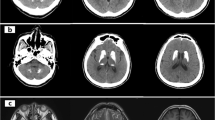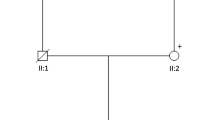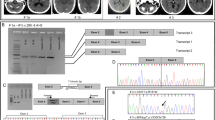Abstract
Idiopathic basal ganglia calcification (IBGC) is a progressive cerebral disorder with diverse motor, cognitive, and psychiatric expression. It is inherited as an autosomal dominant trait. Three IBGC-causing genes have been identified in the past 2 years: SLC20A2, PDGFRB, and PDGFB. Biological and genetic evidence showed that loss of function of either SLC20A2 or the PDGFB/PDGFRB pathway was the mechanism underlying calcification in patients with a mutation. Recently, in a study focusing on SLC20A2, a large deletion at this locus was reported. No study has systematically searched for copy number variants (CNV) involving these three genes. We designed a quantitative PCR assay of multiple short fluorescent fragments (QMPSF) to detect CNVs involving one of these three genes in a single assay. Among the 27 unrelated patients from our IBGC case series with no mutation in SLC20A2, PDGFRB, and PDGFB, we identified in one patient a heterozygous partial deletion involving exons 2 to 5 of PDGFB. This patient exhibited both strio-pallido-dentate calcification and white matter hyperintensity of presumed vascular origin, associated with mood disorder, subtle cognitive decline, and gait disorder. We confirmed by RT-PCR experiments that the allele carrying the deletion was transcribed. The resulting cDNA lacks sequence for several critical functional domains of the protein. Intragenic deletion of PDGFB is a new and rare mechanism causing IBGC. CNVs involving the three IBGC-causing genes should be investigated in patients with no point mutation.

Similar content being viewed by others
References
Avrahami E, Cohn DF, Feibel M, Tadmor R (1994) MRI demonstration and CT correlation of the brain in patients with idiopathic intracerebral calcification. J Neurol 241(6):381–384
Baker, M., A. J. Strongosky, M. Y. Sanchez-Contreras, et al (2013) "SLC20A2 and THAP1 deletion in familial basal ganglia calcification with dystonia." Neurogenetics
Godefroy O, Azouvi P, Robert P, Roussel M, LeGall D, Meulemans T (2010) Dysexecutive syndrome: diagnostic criteria and validation study. Ann Neurol 68(6):855–864
Jensen N, Schroder HD, Hejbol EK, Fuchtbauer EM, de Oliveira JR, Pedersen L (2013) Loss of function of slc20a2 associated with familial idiopathic basal ganglia calcification in humans causes brain calcifications in mice. J Mol Neurosci 51(3):994–999
Keller A, Westenberger A, Sobrido MJ et al (2013) Mutations in the gene encoding PDGF-B cause brain calcifications in humans and mice. Nat Genet 45(9):1077–1082
Le Ber I, Marie RM, Chabot B, Lalevee C, Defer GL (2007) Neuropsychological and 18FDG-PET studies in a family with idiopathic basal ganglia calcifications. J Neurol Sci 258(1–2):115–122
Nicolas, G., A. Jacquin, C. Thauvin-Robinet, et al. (2014). "A de novo nonsense PDGFB mutation causing idiopathic basal ganglia calcification with laryngeal dystonia." Eur J Hum Genet in press.
Nicolas G, Pottier C, Charbonnier C et al (2013a) Phenotypic spectrum of probable and genetically-confirmed idiopathic basal ganglia calcification. Brain 136(Pt 11):3395–3407
Nicolas G, Pottier C, Maltete D et al (2013b) Mutation of the PDGFRB gene as a cause of idiopathic basal ganglia calcification. Neurology 80(2):181–187
Wang C, Li Y, Shi L et al (2012) Mutations in SLC20A2 link familial idiopathic basal ganglia calcification with phosphate homeostasis. Nat Genet 44(3):254–256
Wardlaw JM, Smith EE, Biessels GJ et al (2013) Neuroimaging standards for research into small vessel disease and its contribution to ageing and neurodegeneration. Lancet Neurol 12(8):822–838
Acknowledgments
We are grateful to Tracey Avequin for her help in editing the manuscript. This work was supported by grants from the French Ministry of Health to the CNR-MAJ and sponsored by the University Hospital of Rouen.
Disclosure
We report no disclosures.
Author information
Authors and Affiliations
Corresponding author
Additional information
Dominique Campion and Didier Hannequin contributed equally to this work.
Electronic supplementary material
Below is the link to the electronic supplementary material.
Rights and permissions
About this article
Cite this article
Nicolas, G., Rovelet-Lecrux, A., Pottier, C. et al. PDGFB Partial Deletion: a New, Rare Mechanism Causing Brain Calcification with Leukoencephalopathy. J Mol Neurosci 53, 171–175 (2014). https://doi.org/10.1007/s12031-014-0265-z
Received:
Accepted:
Published:
Issue Date:
DOI: https://doi.org/10.1007/s12031-014-0265-z




